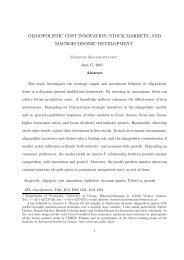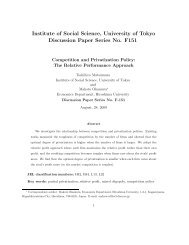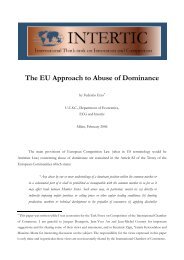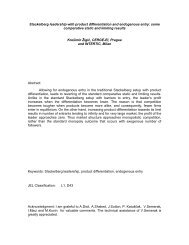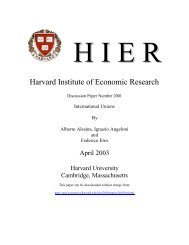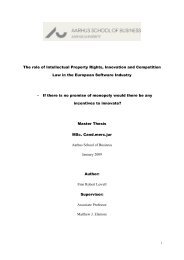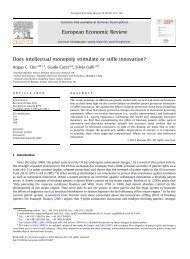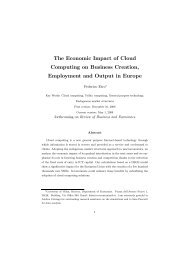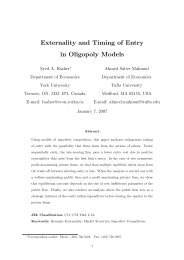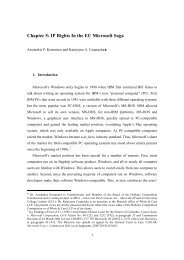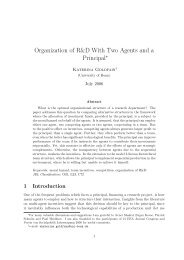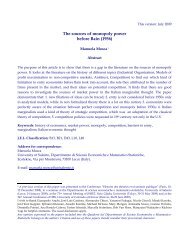"Endogenous Timing with Free Entry" by A. Tesoriere - Intertic
"Endogenous Timing with Free Entry" by A. Tesoriere - Intertic
"Endogenous Timing with Free Entry" by A. Tesoriere - Intertic
You also want an ePaper? Increase the reach of your titles
YUMPU automatically turns print PDFs into web optimized ePapers that Google loves.
<strong>Endogenous</strong> <strong>Timing</strong> <strong>with</strong> <strong>Free</strong> Entry<br />
A. <strong>Tesoriere</strong><br />
Discussion Paper 2006-47<br />
Département des Sciences Économiques<br />
de l'Université catholique de Louvain
CORE DISCUSSION PAPER 2006/93<br />
ENDOGENOUS TIMING WITH FREE ENTRY<br />
Antonio <strong>Tesoriere</strong><br />
SEAF, Università di Palermo and<br />
CORE, Université catholique de Louvain, Louvain-la-Neuve, Belgium<br />
October 2006<br />
ABSTRACT<br />
A free entry model <strong>with</strong> linear costs is considered where firms first choose<br />
their entry time and then compete in the market according to the resulting timing<br />
decisions. Multiple equilibria arise allowing for infinitely many industry output<br />
configurations encompassing one limit-output dominant firm and the Cournot<br />
equilibrium <strong>with</strong> free entry as extreme cases. Sequential entry is never observed.<br />
Both Stackelberg and Cournot-like outcomes are sustainable as equilibria however.<br />
When the number of incumbents is given, entry is always prevented, and industry<br />
output is sometimes larger than the entry preventing level.<br />
JEL Classification: L11, L13.<br />
Keywords: <strong>Free</strong> entry, Market leadership, Entry prevention.<br />
0 I would like to thank Rabah Amir, Paul Belleflamme, Giuseppe De Feo and Giulio Nicoletti<br />
for helpful comments. Financial supports from Università degli Studi di Palermo are gratefully<br />
acknowledged. This text presents results of the Belgian Program of Interuniversity Poles of<br />
Attraction initiated <strong>by</strong> the Belgian state, Prime Minister’s office, Science Policy Programming.<br />
The scientific responsibility is assumed <strong>by</strong> the author.
I. INTRODUCTION. This paper considers a model of competition <strong>with</strong><br />
free entry where firms decide not only whether or not to enter the market, but also<br />
their entry time. In the same spirit as the recent literature on endogenous timing, 1<br />
I address the issue of what order of play one should observe when firms are allowed<br />
to choose first at which period to enter the market and then, given the resultant<br />
timing structure, their output level. A common motivation of many studies in<br />
this area is that in the presence of either a firstoralatermoveradvantage 2 the<br />
sequence of moves should be dealt <strong>with</strong> as an equilibrium phenomenon instead of<br />
being exogenous, especially when firms are ex ante identical. Here I extend the<br />
criterion introduced <strong>by</strong> Hamilton and Slutsky (1990) for the two-period, two-firm<br />
case to encompass endogenous number of firms.<br />
The main features of the framework here are that (i) entry takes place until a<br />
new entrant expects non positive profits in equilibrium, and (ii) given a sequential<br />
pattern of moves in the product market, <strong>with</strong> possibly many firms moving at the<br />
same period, the output decisions of earlier movers are known to subsequent<br />
competitors. So, any possible sequential order of play gives rise to a hierarchical<br />
Stackelberg game where each firm takes the output of earlier and simultaneous<br />
movers as given while exactly predicting the strategies of later movers up to the<br />
1 See, among others, Hamilton and Slutsky (1990) and Mailath (1993). For experimental<br />
evidence on endogenous timing see Huck, Müller, and Normann (2002).<br />
2 As shown <strong>by</strong> Gal-Or (1985) for a duopoly, first and second mover advantages are usually<br />
associated <strong>with</strong> strategic substitutability as in quantity competition <strong>with</strong> homogeneous goods<br />
and to strategic complementarity as in price competition <strong>with</strong> differentiated goods, respectively.<br />
Also see Amir and Stepanova (2006). With free entry and endogenous number of firms, as<br />
in the present paper, the standard taxonomy is preserved and earlier movers have a strategic<br />
advantage. See for instance Lemmas 1 and 2 below.<br />
2
period at which the free entry condition (i) is satisfied.<br />
Three different patterns can apriorirealize. The first case is simultaneous<br />
entry, wherefirms enter the market at the same period and induce a Cournot<br />
equilibrium <strong>with</strong> free entry. The second case is sequential entry in the sense of<br />
Prescott and Visscher (1977), where firms enter one at time, then play a sequential<br />
game <strong>with</strong> perfect information, and induce a subgame perfect Nash equilibrium<br />
(SPNE) <strong>with</strong> free entry. Beyond these two extremes, the third, more general case<br />
is that of a sequential timing structure <strong>with</strong> some firms moving at the same period.<br />
When choosing its entry period, each firm considers its SPNE payoff for the<br />
version of the market stage game that would obtain, that is the market stage game<br />
<strong>with</strong> timing structure defined <strong>by</strong> the firms’ timing decisions. The equilibrium of<br />
the whole game defines the number of firms active in the market, the production<br />
decisions of these firms, and the timing according to which production takes place.<br />
I consider the case of linear costs only. The results can be extended to the case<br />
of concave costs, but possibly do not hold in the presence of increasing marginal<br />
costs.<br />
A key observation in this paper is that, <strong>with</strong> given number of incumbents,<br />
under the free entry assumption, early movers always prevent entry.<br />
This is<br />
because they anticipate that if entry was accommodated then the equilibrium<br />
price would not be larger than in the case of entry preemption. With linear costs<br />
these firms can do strictly better <strong>by</strong> producing the preemptive output themselves<br />
at the first stage.<br />
3
The fact that one Stackelberg leader <strong>with</strong> linear costs might preempt entry<br />
is well recognized in the literature on industrial entry deterrence. Vives (1988)<br />
makes the interesting point that in a hierarchical Stackelberg model <strong>with</strong> sequential<br />
entry and given number of firms, the leader never accommodates entry<br />
of firms which will subsequently block further entry. 3<br />
The mentioned result in<br />
the present paper can be actually seen as directly following from Vives’ observation.<br />
More recently, Etro (2004) studies a free entry Stackelberg model <strong>with</strong><br />
one leader. With linear costs, the leader prevents entry. Similar intuitions are<br />
already in Prescott and Visscher (1977).<br />
As an intermediate result, this paper extends these findings to industries <strong>with</strong><br />
many established firms, <strong>by</strong> showing that <strong>with</strong> linear costs and free entry, any<br />
given number of incumbents deters entry. What is remarkable is that, <strong>with</strong> n<br />
firms moving simultaneously at the first period and free entry in the subsequent<br />
periods, there always exists an equilibrium where only one incumbent produces<br />
the entry preventing output, the remaining (n − 1) firms produce no output, and<br />
the later movers do not enter the market. In addition, other configurations might<br />
be sustainable as equilibria, <strong>with</strong> either m firms producing the entry preventing<br />
output in aggregate and the remaining (n − m) firms producing 0, or<strong>with</strong>then<br />
incumbents producing their Cournot output each and blockaded entry. No other<br />
equilibria exist.<br />
So, one firm contemplating entry will never choose to be a late mover, in which<br />
3 Also see Gilbert and Vives (1986).<br />
4
case it would get non positive profits (net of the fixed cost of production). This<br />
remark is fundamental when treating the number of incumbents as well as the<br />
order of moves as endogenously determined <strong>by</strong> the firms’ decisions, which is the<br />
main interest of this paper. The corresponding point for the case of endogenous<br />
timing is that a candidate follower would prefer either to anticipate its entry<br />
timeornottoenterthemarketatall. Morespecifically, at the SPNE of the<br />
endogenous timing game earlier movers always prevent subsequent entry.<br />
An article close to this paper is Anderson and Engers (1992). 4<br />
For given<br />
number of firms and a certain class of demand functions allowing for linear demand<br />
as a specific case, they consider a game including both Stackelberg <strong>with</strong><br />
sequential entry and Cournot equilibria as possible outcomes and show that the<br />
equilibrium is Stackelberg. The present paper finds that <strong>with</strong> endogenous timing<br />
and free entry, sequential play is never observed. However, both Stackelberg and<br />
Cournot-like outcomes are sustainable as equilibria. Namely, the endogenous timing<br />
game has multiple SPNE describing a wide range of industry configurations.<br />
Whether one configuration <strong>with</strong> only one firm active in the market producing the<br />
entry preventing output, or any configuration <strong>with</strong> m ≤ n ∗ firms active in the<br />
market at period 1, producing an aggregate output which is the largest between<br />
the entry preventing output and the Cournot output <strong>with</strong> m firms, and no firm<br />
entering in subsequent periods is a SPNE of the whole game, where n ∗ is the<br />
number of firms active in the market at the Cournot equilibrium <strong>with</strong> free entry.<br />
4 Also see Matsumura (1999).<br />
5
No other configuration is an equilibrium.<br />
The paper is organized as follows: Section II describes the model and some<br />
preliminary results; Section III features the equilibria of the game; Section IV<br />
provides a discussion and briefly concludes.<br />
II. THE MODEL. This paper characterizes the equilibria of an industry<br />
<strong>with</strong> free entry where firms first choose their entry time and then compete in the<br />
market following the sequence of moves resulting from their entry decisions. When<br />
entering the market, a firm observes the aggregate output of current incumbents<br />
(if any) and decides how much to produce taking the actions of simultaneous<br />
entrants as given, while perfectly predicting the strategy of later movers. Entrants<br />
that are active in the market are identical in that they produce a homogeneous<br />
good <strong>with</strong> inverse demand p (.) and face the same constant marginal cost c>0.<br />
More precisely, p (.) is downward sloping and twice continuously differentiable.<br />
These firms also bear a setup cost F .<br />
Hence the cost function of a firm i is<br />
c(q i )=cq i + F for q i > 0 and c(q i )=0otherwise.<br />
The timing of the game is as follows. In the first or preplay stage, there is a<br />
large enough number of firms contemplating entry. 5<br />
These firms simultaneously<br />
choose whether or not to enter the market and at which period t ∈ N. By entering<br />
the market at time t, afirm commits to produce at that time and only at that<br />
5 See, for instance, Mankiw and Whinston (1986).<br />
6
time. 6 The action set of firm i at the preplay stage is A i = {enter, not enter}×N. 7<br />
Once the timing decisions are taken, they become common knowledge and the<br />
market stage game is played according to the timing structure stemming from<br />
the preplay stage.<br />
Let n be the number of firms choosing enter at the preplay stage. Also let<br />
s ≤ n be the number of different periods chosen in the preplay stage. Finally,<br />
let N τ be the set of firms choosing t = τ at the preplay stage. The market<br />
stage can be viewed as an s-stage game G whose players are the active firms.<br />
When N τ is a singleton for any τ, G corresponds to the hierarchical Stackelberg<br />
game <strong>with</strong> sequential entry described in Vives (1988) and Anderson and Engers<br />
(1992), <strong>with</strong> the major addition of the free entry assumption. Otherwise there<br />
areatleasttwofirms playing simultaneously at some period τ, inwhichcaseany<br />
firm in N τ observes the output of all previous movers and makes a simultaneous<br />
choice relative to other firms in N τ . Each firm also predicts the strategy played<br />
<strong>by</strong> subsequent competitors correctly. So, firms which move at the same period<br />
are Cournot competitors to each other, Stackelberg leaders for later movers, and<br />
Stackelberg followers <strong>with</strong> respect to earlier entrants.<br />
Let τ ∗ be the firstperiodatwhichatleastonefirm chooses to enter the<br />
market. Given the timing structure for the market stage game, a strategy S iτ ∗<br />
for firm i ∈ N τ ∗ is an output level q i . For τ = τ ∗ , a strategy S iτ for firm<br />
6 As stressed <strong>by</strong> Hamilton and Slutsky (1990), this assumption is not restrictive, since the<br />
timing of entry rests on firms’ decisions and no firm will deviate in equilibrium.<br />
7 As emphasized in the literature, entry decisions here do not take place in real time. That is,<br />
different timing structures leading to the same order of entry can be thought of as equivalent.<br />
7
i ∈ N τ is a function of the aggregate production of firms in periods preceding τ,<br />
r i : R + −→ R + .<br />
The whole or extended game is obtained <strong>by</strong> adding the preplay stage to the<br />
market stage described above. A strategy for firm i intheextendedgameisa<br />
pair (a i , φ i ),wherea i ∈ A i ,andφ i : A n i → {S iτ ∗,S iτ }.<br />
I assume that a firm enters the market if and only if this firm obtains strictly<br />
positive profits in the SPNE of the market stage induced <strong>by</strong> its timing decision.<br />
The profit offirm i is Π i (Q − i + q i )=(p(Q − i + q i ) − c) q i − F ,ifq i > 0 and<br />
0 otherwise, where q i is the output of that firm and Q − i is the output of all<br />
firms other than i. I also assume that output levels are strategic substitutes, i.e.<br />
p q i + p < 0. It follows that Π i (.) is strictly concave in q i . Finally, I assume that<br />
there exists a free-entry Cournot equilibrium, that is an integer number of firms<br />
n ∗ and a set of outputs forming a Cournot equilibrium <strong>with</strong> n ∗ firms, such that<br />
no other firm would obtain positive Cournot equilibrium profits <strong>by</strong> entry. 8<br />
For<br />
further reference, n ∗ will denote the number of firmsactiveinthemarketatthe<br />
Cournot equilibrium <strong>with</strong> free entry.<br />
As a preliminary step, I now consider two specific versions of the market<br />
stage game G, both allowing for free entry and displaying an exogenous timing<br />
8 Given the assumptions here, if a free-entry equilibrium exists, then it must be unique. In<br />
fact, for any number of firms n, there exists a unique and symmetric Cournot equilibrium. In<br />
addition, the per firm Cournot equilibrium profit <strong>with</strong>n firms is strictly decreasing in n. So<br />
asufficient condition for the existence of the (unique) free-entry Cournot equilibrium is that<br />
the equilibrium per firm profit tendsto0 when n grows indefinitely. Finally notice that under<br />
thefreeentryconditionstatedhereandsincec (0) = 0, firms active at the free-entry Cournot<br />
equilibrium makes strictly positive profits.<br />
8
structure. The related results in Lemma 1 and 2 below facilitate the analysis for<br />
the case of endogenous timing. Nonetheless, they might also be of independent<br />
interest to the IO literature on entry deterrence.<br />
Game G 1 : In game G 1 only a single firm is in the market at period 1. Inthis<br />
stage, the sole incumbent decides how much to produce taking into account the<br />
strategies of potential entrants. At any subsequent period each of possibly many<br />
potential entrants observes the aggregate output in the market and then decides<br />
whether to enter or not and how much to produce, anticipating the strategies<br />
of further entrants correctly and until the free entry condition is satisfied. More<br />
precisely, G 1 is meant to capture any version of the market stage game G where<br />
τ ∗ =1, N τ ∗<br />
=1,andN τ ≥ 0 for τ > 1, that is a Stackelberg game <strong>with</strong> free<br />
entry and only one firm in the first period.<br />
Let Y satisfy (p(Y + q ∗ i (Y )) − c) q∗ i (Y )=F ,whereq∗ i<br />
(q) is the unique root<br />
of ∂Π i(q+q i )<br />
∂q i<br />
=0. Since qi ∗ (Y ) stems from the first order condition for the maximization<br />
of Π i (Y + .), there is no q i > 0 giving firm i positive profits when earlier<br />
movers produce Y .Moreover,(. + q ∗ i (.)) is increasing and q∗ i<br />
(.) is decreasing. It<br />
follows that for any cumulative output of the incumbents Z ≥ Y , the potential<br />
entrant best reacts <strong>by</strong> not entering the market. 9<br />
Specifically, r i (Y )=0,where<br />
r i (.) is the reaction function of any potential entrant i as defined above. Henceforth<br />
Y will be referred to as the entry preventing output. I assume that entry is<br />
9 This implies that Y is unique. See Vives (1988) for a complete characterization of the<br />
potential entrant’s reaction function in the case of linear demand.<br />
9
not blockaded, that is the monopoly output y m <br />
(p (Y + q ∗ i (Y )) − c) q∗ i<br />
(Y )=F , so the incumbent obtains positive profits. This<br />
fact is summarized <strong>by</strong> the following lemma.<br />
Lemma 1: Game G 1 has a unique SPNE <strong>with</strong> only one firm in the market,<br />
producing at period 1 the output Y which satisfies (p (Y + q ∗ i (Y )) − c) q∗ i<br />
(Y )=F ,<br />
and getting positive profits.<br />
Etro (2004) obtains the same result for a Stackelberg game <strong>with</strong> only one<br />
leader and many simultaneous followers. 10<br />
While focusing on the special case<br />
of a single incumbent as well, the discussion above introduces a general enough<br />
argument to be extended to the more realistic case of an industry <strong>with</strong> many<br />
firms at period 1. If the incumbents anticipate that the equilibrium price <strong>with</strong><br />
10 He proceeds <strong>by</strong> totally differentiating both the first order conditions and the zero profit<br />
condition for the followers when treating the number of firms as a continuous variable, and<br />
shows that the maximization problem of the leader has a corner solution <strong>with</strong> entry deterrence<br />
if costs are linear.<br />
10
free entry cannot be larger than the price clearing the market when the aggregate<br />
output is Y , then each of them will try to spread the fixed markup at p (Y ) over<br />
the largest possible market share, that is the incumbents will compete to deter<br />
entry. This fact, that is reckoned <strong>with</strong> <strong>by</strong> the existing literature, has not received<br />
a formal treatment yet. What follows is meant to take a step in this direction.<br />
Game G n : Game G n extends G 1 to the case of n firms producing simultaneously<br />
at period 1. More precisely, G n covers any version of the market stage<br />
game G <strong>with</strong> τ ∗ =1, N τ ∗<br />
= n, andN τ ≥ 0 for τ > 1. Consider n ≤ n ∗ only,<br />
where n ∗ is the number of firms in the Cournot equilibrium <strong>with</strong> free entry as<br />
mentioned above. When choosing its output level, each of these firms takes the<br />
output of the other (n − 1) incumbents as given, while anticipating correctly the<br />
best response of new entrants. Since a firm i ∈ N 1 acts as a Cournot competitor<br />
<strong>with</strong> respect to simultaneous movers, its best response to an aggregate output<br />
level of the other incumbents Z ≥ Y is 0. Given the assumption of linear costs,<br />
following the same argument as for game G 1 ,forZ
where Z is the cumulative output of the (n − 1) firms in N 1 different than i, and<br />
q ∗ i<br />
(.) is defined as above.<br />
It first follows from (1) that any output configuration <strong>with</strong> only one firm<br />
producing the entry preventing output Y and the other (n − 1) firms in N 1 producing<br />
0 is a SPNE of G n . 11<br />
(1) also says that when firm i’s Cournot reaction<br />
function q ∗ i (Z) lies above the line q i<br />
= Y − Z, firm i behaves as a Cournot<br />
competitor irrespective of the strategies of the potential entrants. Let now q Cn<br />
i<br />
denote the Cournot equilibrium output of firm i when there are n firms active<br />
on the market, i.e. the equilibrium output of the game when the n firms move<br />
simultaneously and no further entry is allowed. It is well known that for the case<br />
at hand, this equilibrium is unique and symmetric, so that q Cn<br />
i = q Cn , for all i. 12<br />
Therefore, if nq Cn ≥ Y , then each incumbent producing q Cn and no other firm<br />
entering the market in subsequent periods is a SPNE of G n .Inthiscase,forany<br />
Z>(n − 1) q Cn , r n i (Z) =q∗ i (Z) for any i.13 This, together <strong>with</strong> the uniqueness<br />
of the Cournot equilibrium <strong>with</strong> n firms, implies that when nq Cn ≥ Y ,thereis<br />
no other SPNE. Analogously, if nq Cn
There are possibly infinitely many such equilibria.<br />
In particular, for m ≤<br />
n, any output configuration satisfying (2.a) above, <strong>with</strong> m firms producing the<br />
aggregate output Y and the remaining (n − m) firms in N 1 producing 0, isa<br />
SPNE of G n . In this case, any incumbent producing a strictly positive output<br />
makes strictly positive profits. 14<br />
It is worth noting that game G n encompasses game G 1 as a special case, i.e.<br />
n =1. Note also that the aggregate output n ∗ q Cn∗<br />
at the Cournot equilibrium<br />
<strong>with</strong> free entry is larger than the entry preventing output Y . To see that, observe<br />
that the number of firms at the Cournot equilibrium <strong>with</strong> free entry n ∗ satisfies<br />
<br />
p<br />
<br />
n ∗ q Cn∗ +1 + q ∗ n ∗ q Cn∗ +1 − c q ∗ n ∗ q Cn∗ +1 ≤ F .<br />
This means that even<br />
the monopoly output relative to the residual demand of the potential entrant<br />
gives this firm non positive profits. So output n ∗ q Cn∗ +1 would also block entry in<br />
the hierarchical Stackelberg model, which implies n ∗ q Cn∗ +1 ≥ Y .Sinceq Cn∗ +1 <<br />
q Cn∗ ,itfollowsthatn ∗ q Cn∗ >Y. These facts are summarized in Lemma 2, where<br />
use is made of the following definition:<br />
let n ∈ R satisfy nq Cn ≷ Y ifandonlyifn ≷ n. (3)<br />
Note that n defined in (3) exists for the reason that y m (p (Y + q ∗ (Y )) − c) q ∗ (Y )=F .<br />
15 See, for instance, Amir and Lambson (2000).<br />
13
all moving at period 1, producing aggregate output Z n ≥ Y and obtaining strictly<br />
positive profits. There always exists a SPNE <strong>with</strong> one firm producing Y and the<br />
remaining (n − 1) firms producing 0. In addition, there exist a real number n<br />
such that, if and only if nn≥ n, the Cournot output deters entry of followers only, while it is not<br />
enough to prevent that of a simultaneous competitor. A remark of independent<br />
interest relates to the effects of a change of F .<br />
Given the assumptions here,<br />
p (Y + qi ∗ (Y )) q∗ i (Y ) is strictly decreasing in Y . So a rise of F causes the entry<br />
preventing output Y to reduce. Since a change of F leaves the Cournot reaction<br />
functions qi ∗ (Y ) unaffected while reducing Y ,alargersetupcostwillalsoreduce<br />
n.<br />
Example: Consider game G 2 <strong>with</strong> linear demand a − (q 1 + q 2 ) and c =0. I<br />
assume a>4 √ F , which implies that entry is not blockaded. The entry preventing<br />
output is Y = a − 2 √ F . Given this setup, at the Cournot equilibrium <strong>with</strong> two<br />
14
firms, each firm produces q C2 = a 3<br />
. The reaction function of firm 1 is:<br />
⎧<br />
⎪⎨ 0 if q 2 ≥ a − 2 √ F<br />
r1 2 (q 2 )= 1<br />
⎪⎩ 2 (a − q 2) if a − 2 √ F>q 2 ≥ a − 4 √ F ,<br />
a − 2 √ F − q 2 if a − 4 √ F>q 2<br />
and similarly for firm 2. SoG 2 has the following equilibria: if 6 √ F>a>4 √ F ,<br />
(a) only one firm active in the market, producing output a − 2 √ F at period 1;<br />
(b) only two firms active in the market, producing output a 3 each. If a ≥ 6√ F ,<br />
(c) only one firm active in the market, producing output a−2 √ F at period 1; (d)<br />
only two firms active in the market, producing any output configuration satisfying<br />
both q 1 = a − 2 √ F − q 2 and a − 4 √ F ≥ q 2 ≥ 2 √ F .<br />
Figure 1 describes the reaction curves for the game at hand; the thicker line<br />
is the reaction curve of firm 1. The equilibria of type (d) lie on the segment line<br />
AB.<br />
15
Figure 1: Game G 2 <strong>with</strong> linear demand<br />
III. EQUILIBRIA. A SPNE of the extended game is a set N E of n firms<br />
active in the market stage game, together <strong>with</strong> a vector of timing decisions t ∈<br />
N n , and a vector of output decisions q ∈ R n , such that, (.) the output decisions<br />
of the active firms constitute a SPNE of the market stage game <strong>with</strong> timing<br />
structure t, and(..) given t and n, nofirm i ∈ N E can profitably deviate from t,<br />
and no firm i/∈ N E can profitably enter the market.<br />
Given Lemmas 1 and 2 above, in a SPNE equilibrium of the extended game,<br />
16
at least one firm is active at period 1. Indeed if no firm was entering at that time,<br />
then there would be at least one firmobtainingaSPNEprofit strictly smaller than<br />
the profit going to the Stackelberg leader in game G 1 described in the previous<br />
section, and then being strictly better off <strong>by</strong> choosing to enter at period 1. Asa<br />
consequence, any vector t substantiable in the SPNE of the extended game gives<br />
rise to a market stage game of the form G n discussed above. It then follows that<br />
in a SPNE of the market stage, no firm enters at period t ≥ 2. This is because,<br />
as argued in Lemma 2 above, at any SPNE of G n the aggregate output of the<br />
incumbents is not smaller than the entry preventing output Y .<br />
So sequential<br />
entry is never observed.<br />
Since for n>1, anygameG n has multiple equilibria, a firm deviating from its<br />
current entry decision must consider any of these equilibria separately, as alternative<br />
standard for the resultant market stage game. The SPNE configurations<br />
of the extended game are summarized in the following proposition.<br />
PROPOSITION: Let n ∗ and n be defined as in Section II and in (3) above,<br />
respectively. Also, let Y be defined as in Lemma 1 above. At any SPNE of the<br />
extended game there are m firms entering the market at period 1 and no firm<br />
entering at subsequent periods, where m ≤ n ∗ .<br />
Any of the following configurations is a SPNE of the extended game:<br />
(1) Only one firm enters the market at period 1 and produces Y .<br />
(2) Only m firms, <strong>with</strong> m
(2.a) mentioned in the previous section.<br />
(3) Only m firms, <strong>with</strong> n ≤ m ≤ n ∗ , enter the market at period 1 and produce<br />
q Cm each, <strong>with</strong> mq Cm >Y.<br />
No other configuration is sustainable as SPNE of the extended game.<br />
PROOF: The first part of the proposition follows from the previous discussion.<br />
The fact that m ≤ n ∗ follows from the definition of n ∗ . Given this, the<br />
remainder of the proof just considers the problem of a firm e contemplating entry.<br />
(1) From Lemma 1 in the previous section, game G 1 has a unique SPNE<br />
<strong>with</strong> the only incumbent producing the entry preventing output Y . Given this<br />
equilibrium, entry <strong>by</strong> firm e would induce a market stage game G 2 . Irrespective<br />
of 2 being larger or smaller than n, game G 2 has a SPNE where the former<br />
incumbent produces Y while the entrant produces 0. This follows from Lemma<br />
2. Taking this equilibrium as the benchmark for game G 2 ,entrywouldyieldfirm<br />
e no profit. So no firm e enters the market and the configuration in (1) is an<br />
equilibrium.<br />
(2) From Lemma 2 in the previous section, game G m has a SPNE <strong>with</strong> m<br />
firms active in the market and producing the aggregate output Y . Given this<br />
equilibrium, entry <strong>by</strong> firm e would induce a market stage game G m+1 . Irrespective<br />
of m +1being larger or smaller than n, game G m+1 has a SPNE where only one<br />
firm i = e produces Y while the remaining m firms produce 0. Again,thisfollows<br />
from Lemma 2. Taking this equilibrium as the benchmark for game G m+1 ,entry<br />
would yield firm e no profit. So no firm e enters the market and the configuration<br />
18
in (2) is an equilibrium.<br />
(3) From Lemma 2 in the previous section, for m ≥ n, game G m has a<br />
SPNE <strong>with</strong> m firms active in the market and producing q Cm<br />
each. Since m ≤<br />
n ∗ , each incumbent makes positive profits.<br />
Given this equilibrium, entry <strong>by</strong><br />
firm e would induce a market stage game G m+1 . Again, from lemma 2, G m+1<br />
has one equilibrium <strong>with</strong> only one firm i = e producing Y and the remaining<br />
m firms producing 0. This equilibrium gives firm e zero profit. So taking it<br />
as the benchmark for game G m+1 ,nofirm e would enter the market, and the<br />
configuration in (3) is an equilibrium.<br />
To see that there are no other SPNE remind that any output vector sustainable<br />
as a SPNE of the extended game must be a SPNE of a related market stage game,<br />
together <strong>with</strong> the fact that any market stage game which is sustainable in a SPNE<br />
of the extended game is of the form G n described in the previous section.<br />
IV. CONCLUSION. This paper has examined a model of market competition<br />
<strong>with</strong> both free entry and endogenous timing for entry decisions. Under the<br />
assumption of linear production costs, there are multiple equilibria allowing for<br />
many industry output configurations that encompass one limit-output dominant<br />
firm and the Cournot equilibrium <strong>with</strong> free entry as extreme cases.<br />
Infinitely<br />
many other configurations in between, <strong>with</strong> m
other equilibria exist.<br />
The result here rests on equilibrium properties of industrial contexts where<br />
many established incumbents cope <strong>with</strong> an infinite number of potential entrants<br />
as described <strong>by</strong> game G n in section II. Previous studies argued that in the case<br />
of a given number of entrants, entry prevention is a public good to the extent<br />
that the benefit from preventing entry is not perfectly appropriable <strong>by</strong> the larger<br />
incumbent. 16 This might lead to underinvestment in entry deterrence. This paper<br />
shows that <strong>with</strong> free entry and linear costs, underinvestment is never the case.<br />
Instead, each incumbent has strong incentives to produce the entry preventing<br />
output <strong>by</strong> itself, and any configuration <strong>with</strong> m ≤ n firms producing this output<br />
and the remaining ones producing 0 is an equilibrium. With a larger number of<br />
incumbents, i.e. n>n, entry is blockaded <strong>by</strong> the n-firms Cournot output. 17<br />
A<br />
related point is that unlike the standard setting for endogenous timing <strong>with</strong> two<br />
firms, here simultaneous play does not necessarily means a Cournot-like output.<br />
While the results here hold <strong>with</strong> concave costs, 18 they need not hold in the<br />
case of increasing marginal costs. However, the analysis is still valid <strong>with</strong> U-<br />
shaped average cost curves whenever the entry preventing output is smaller than<br />
the incumbents’ minimum efficient scale. A welfare analysis is not immediate.<br />
When total output is Y , welfare is decreasing in the equilibrium number of firms,<br />
even in the specific case of linear costs, and the socially efficient number of firms is<br />
16 See for instance, Bernheim (1984) and Waldman (1987).<br />
17 A similar result is reported in Gilbert and Vives (1986).<br />
18 In this case the further assumption −p + c > 0 is needed. See Amir and Lambson (2000).<br />
20
1. As demonstrated <strong>by</strong> Mankiw and Whinston (1986), when n = n ∗ ,therearetoo<br />
many firms operating in the market. But, for n>n, the loss in industrial profits<br />
must be contrasted against the benefits to consumers from the larger aggregate<br />
output, which is something beyond the scope of this paper.<br />
Finally, a natural consideration is that removing barriers to entry in an industry<br />
could cause the number of firms to reduce. This point may be of some<br />
interest when looking at industries <strong>with</strong> too many inefficient firms. The paper<br />
might suggest that despite the large number of firms in the market, inefficiencies<br />
in these industries are caused <strong>by</strong> barriers to entry which dissuade incumbents<br />
from investing in entry prevention and in efficient scale. 19<br />
REFERENCES<br />
Amir, R., Lambson, V. E., 2000. On the Effect of Entry in Cournot Markets.<br />
Review of Economic Studies 67, 235-254.<br />
Amir, R., Stepanova, A., 2006. Second-mover Advantage and Price Leadership<br />
in Bertrand Oligopoly. Games and Economic Behavior 55 (1), 1-20.<br />
Anderson, S., Engers, M., 1992. Stackelberg versus Cournot Oligopoly Equilibrium.<br />
International Journal of Industrial Organization 10, 127-135.<br />
Banca d’Italia, 2005. Considerazioni Finali 2004. Assemblea Generale Ordinaria<br />
dei Partecipanti.<br />
19 This is, for instance, the case of many industries in Italy, where a large number of small<br />
firms produces at high average costs. See Banca d’Italia (2005). Another example is the retail<br />
industry in India <strong>with</strong> many little shops accounting for 6-7% of national employement and a<br />
land-ceiling legislation preventing entry at efficient scale in many states. See the Economist<br />
(2006).<br />
21
Bernheim, B., 1984. Strategic Deterrence of Sequential Entry into an Industry.<br />
Rand Journal of Economics 15, 1-11.<br />
The Economist, 2006. Special Report Retailing in India. April 15th.<br />
Etro, F., 2004. Stackelberg Competition <strong>with</strong> <strong>Endogenous</strong> Entry. mimeo.<br />
Gal-Or, E., 1985. First Mover and Second Mover Advantages. International<br />
Economic Review 26 (3), 649-653.<br />
Gilbert, R., Vives, X., 1986. Entry Deterrence and the <strong>Free</strong> Rider Problem.<br />
Review of Economic Studies LIII, 071-083.<br />
Hamilton, J., Slutsky, S. M., 1990. <strong>Endogenous</strong> <strong>Timing</strong> in Duopoly Games:<br />
Stackelberg or Cournot Equilibria. Games and Economic Behavior 2, 29-46.<br />
Huck, S., Müller, W., and Normann, H. 2002. To Commit or not to Commit:<br />
<strong>Endogenous</strong> <strong>Timing</strong> in Experimental Duopoly Markets. Games and Economic<br />
Behavior 38, 240-264.<br />
Mailath, G. J., 1993. <strong>Endogenous</strong> Sequencing of Firms Decisions. Journal of<br />
Economic Theory 59, 169-182.<br />
Mankiw, N. G., Whinston,M. D., 1986.<br />
<strong>Free</strong> Entry and Social Efficiency.<br />
Rand Journal of Economics 17 (1), 48-58.<br />
Matsumura, T., 1999. Quantity-setting Oligopoly <strong>with</strong> <strong>Endogenous</strong> Sequencing.<br />
International Journal of Industrial Organization 17, 289-296.<br />
Prescott, E. C., Visscher, M., 1977. Sequential Location among Firms <strong>with</strong><br />
Foresight. Bell Journal of Economics 8, 378-393.<br />
Vives, X., 1988. Sequential Entry, Industry Structure and Welfare. European<br />
22
Economic Review 32, 1671-1687.<br />
Waldman, M., 1987. Noncooperative Entry Deterrence, Uncertainty, and the<br />
free Rider Problem. Review of Economic Studies LIV, 301-310.<br />
23
Département des Sciences Économiques<br />
de l'Université catholique de Louvain<br />
Institut de Recherches Économiques et Sociales<br />
Place Montesquieu, 3<br />
1348 Louvain-la-Neuve, Belgique<br />
ISSN 1379-244X<br />
D/2006/3082/047



